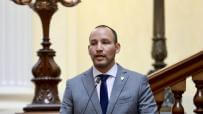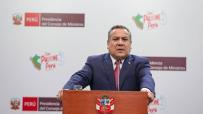
Indigenous leader Mario Guari had warned a decade ago that the voracious rush for gold would destroy part of his community on the banks of the Madre de Dios River on Bolivia's Amazonian border with Brazil. He was not heeded. Today, ten years later, Miraflores, a small town inhabited by indigenous Tacanas in the department of Pando, is suffering the severe consequences: the houses located on the banks of the river have begun to crumble due to land removal by illegal dredgers.
Over the last decade, illegal mining has spread to Bolivia's Amazonian rivers. On the Madre de Dios River, gold mining advances with dredges, on protected areas and indigenous communities. They do not have a license to operate, but they do it anyway, injecting mercury into the water currents and into the bodies of the indigenous inhabitants who feed on the poisoned fish.
Gold has displaced natural gas as Bolivia's main export product. Despite this, an investigation conducted over seven months by OjoPúblico's Crossborder Network and El Deber —as part of the Amazon Dirty Gold series in five countries, which involved 18 journalists— reveals the increase in dredging on Bolivian rivers and the enormous opacity regarding gold in this country.
Since 2016, unlike other countries in the region such as Chile, Peru, Ecuador and Colombia, Bolivia does not report the details of its gold shipments; neither its exporters nor its importers. Only approximate amounts officially declared to Customs are known preliminarily, although experts say the figures could be higher.
OjoPublico's analysis —based on a global database constructed with available customs information for this country— found that between 2014 and 2023 Bolivia exported at least 409 tons of gold. However, production figures are much lower.
In 2022, for example, Bolivia declared in customs that it sold 63 tons and in 2023, 19 tons. But production —according to figures from the Ministry of Mining and Metallurgy— in 2022 was only 53 tons.

IMPACT. Three dredges join forces to extract gold from the base of the Madre de Dios River, on the Bolivian side.
Photo: Manuel Seoane
For Alfredo Zaconeta, researcher at the Center for Labor and Agrarian Development Studies (CEDLA, in Spanish), there are facts that should be taken into account in the informal gold production in Bolivia. The first is the considerable increase in gold production in the last nine years, which went from 13.4 tons in 2013 to 53 tons in 2022.
The second point, as this investigation by OjoPúblico and El Deber has warned, is the huge gap between production and exports. "This variation in figures and their increase in recent years leads to the hypothesis that there is smuggling into Bolivia of gold mined in other countries such as Peru and Brazil," says Zaconeta.
The gold boom in Bolivia originated in 2014, when cooperativas increased production, and pushed this extractive industry into new territories, such as the Bolivian Amazon. That year, the new Mining and Metallurgy Law was approved.
But the presence of illegal gold in Bolivia is much greater. The same government estimated in 2023, when Law 1503 for the purchase of gold to strengthen international reserves was being debated, that 50% of gold exports in this country came from illegal sources, mainly through smuggling from Peru.
"We presume and we are sure that a very important amount of gold production is going towards smuggling, which has not been monitored by our directorates. It is a large amount almost similar to the production we have had in 2019," then Minister Ramiro Villavicencio stated in May 2023.
The analysis carried out by OjoPúblico's Crossborder Network and El Deber of a database of gold exports from five Amazonian countries —built with information from customs— shows that during the last two years the main destinations for gold were India, the United Arab Emirates, Hong Kong and Turkey.
The participation of India and the United Arab Emirates as new destinations for gold sold by Bolivia was consolidated in 2022. That year, 93% of all registered exports were concentrated in these two countries.
Gold mining in Bolivia is controlled by mining cooperativas: They produce 99% of all officially declared gold in the country. "[They] do not pay taxes, illegally associate with national and foreign private capital, and leave significant environmental impacts on the environment," states a report from January of this year by the Center for Labor and Agrarian Development Studies (CEDLA, in Spanish).
Gold smuggling between Peru and Bolivia
The miners on the Madre de Dios River say they don't know where the gold they extract goes. "We know the owners of the dredges, but we don't know what they do with the gold," says Fernando, a miner who works on a dredge in the department of Pando. He says that on a good day, he can extract between 25 and 30 grams of gold with a dredge and that the minimum he can get is eight grams.
Bolivian authorities acknowledge that the quantities of gold exports are higher, not only because of increased production of illegally sourced gold, but also because of smuggling from Peru. "Since 2015, Bolivian and Peruvian gold exports maintained an increasing trend, but, given that Peruvian authorities initiated a strong campaign to combat informal mining activity in that country, this apparently produced flows of gold smuggling into Bolivia," the Bolivian government acknowledged in 2021.
Bolivia borders Peru in two regions: Puno and Madre de Dios, both illegal gold producing areas. In these areas, there are several routes for smuggling mercury from Bolivia to Peru, and gold from Peru to Bolivia. Sophisticated smuggling networks exist between Peru and Bolivia. "The relative ease with which gold is laundered and traded in Bolivia makes the country an attractive destination for illegally sourced gold, which reduces the risk of detection and seizure," explains a report by the Organization of American States (OAS).

TRADE. In the Bolivian city of Riberalta, a large number of gold buying and selling shops are observed. This valuable metal is coveted in this Amazonian area.
Photo: Manuel Seoane
Gold mining begins in the Yungas of La Paz, where the Beni, Kaka and Tuichi rivers flow through. There are protected areas affected by this extraction, such as Madidi and Pilón Lajas, both national parks. One of the most affected rivers is the Madre de Dios River, where an estimated 600 dredges are operating.
Alex, as we will call one of the miners who asked not to be identified, talks about the working conditions on the dredges.
"It is very hard to be here. We mine gold from March to November, most of the people work in the chestnut harvest between December and April. But I stay here mining all year round, it is a very risky job, very tiring and it pays very little. There are two ways of mining here: one with the dredges and the other manually. Most of us are with the dredges," he says. The heat makes him uncomfortable.
He says that there is a lot of gold in the Madre de Dios River and that is why they take advantage of the dredge work. Alex is an employee. The owner of the dredges pays him a percentage. About the gold he manages to extract, he says that he is paid "3% of what is recovered".
Since 2016, unlike other countries in the region such as Chile, Peru, Ecuador, and Colombia, Bolivia does not report the details of its gold shipments."
In Riberalta, in the department of Beni, a gram of gold is bought for 400 bolivianos, a little more than 57 dollars. If a miner extracts ten grams he receives 3% of the sale, which is 120 bolivianos or 17 dollars in one day. These prices can vary in different Bolivian cities. For example, in La Paz, Bolivia's capital, a gram of gold is priced at up to 450 bolivianos (USD 60).
In the second quarter of 2023, the gold price reached record highs.
Some twenty companies lead the commercialization of gold in Bolivia. These firms are intermediaries dedicated to the export of the metal. Among the main ones are Empresa Bolivia Precious Metales S.A., Boligroup Traiders S.R.L., Goldway S.R.L., Unión 6 de Agosto S.R.L., Golden Rain S.R.L., Yellow Tree S.R.L., Koryaliri S.R.L. and Chama Khory S.R.L. From 2019 to 2022, these eight companies concentrated 84% of gold exports in the country, according to official data.
Between legal and illegal
Alfredo Zaconeta, researcher at CEDLA, points out that although gold exports in 2022 exceeded those of hydrocarbons, the Bolivian government collected more money for gas than for gold. This is due to the tax differences applied to mining cooperatives.
"There are also clear signs of tax evasion, as private actors (national and foreign) camouflage themselves behind the cooperativas to avoid paying taxes. This is evidenced by the fact that most of the concessions in the Bolivian Amazon are in the name of private companies, but 99% of the gold is extracted as if it belonged to cooperatives", details Zaconeta.
In Bolivia, if a private company extracts gold and passes it off as coming from a cooperative, it avoids paying up to 37.5% Corporate Income Tax (IUE), 13% Value Added Tax (VAT), 3% Transaction Tax (IT) and up to 7% in royalties.
The cooperativa mining sector has indicated that it is willing to pay a single 4.8% tax and has stressed that its contribution to the country should not only be measured in terms of taxation, but also in the generation of employment and economic movement in several regions. Ramiro Balmaceda, president of the Federation of Gold Mining Cooperativas of Northern La Paz (FECOMAN, in Spanish), said in 2022 that his group agrees with paying a single tax, but admitted that the mining cooperative sector in Bolivia is divided on this point.
Bolivia's Minister of Mining and Metallurgy, Marcelino Quispe, in an interview with OjoPúblico, said that "three large projects" are outlined to extract gold in Bolivia through state-owned companies on the Beni, Madre de Dios and Picosutu rivers.
CAMPS. In recent years, some companies extract gold around the clock. In surrounding areas, mining camps are built to recover the mineral that mining does not collect.
Photo: Manuel Seoane
Regarding the project in the Madre de Dios river basin, he stated that "there is a judicial problem, since the community members insisted that no work be done in the rivers". In spite of this, the Minister assured that the problem "will be solved" and that "at least five companies will be established, both state and private".
The Ministry of Mining explained that the "judicial problem" they are referring to is a legal action (known as a popular action) that a group of indigenous people has filed against gold mining in the rivers.
Ruth Alipaz, leader of the National Coordinator for the Defense of Indigenous Peasant-Origin Territories and Protected Areas, an organization that opposes these mining projects, denounced that most of the indigenous people living on the banks of the rivers where gold is extracted are already contaminated with high levels of mercury.
The leader's voice is heard loudly in the Amazon communities. "The defenders of the rainforest have been deprived of the right to have a family lunch, a birthday celebration. There is the photo with us and the photo without us, because it is preferable not to appear publicly with our loved ones, to protect them from violence and attacks," she laments.
Minister Quispe says that mercury will not be used to extract gold in the new mining projects that the government is promoting on the Amazon rivers. "There should be no fear, since the proposed projects do not consider the use of mercury. Gold will be obtained by gravimetric methods," he responded.
Illegal miners have found fertile ground in several areas of the Bolivian Amazon. Their power and influence have undermined the ability of park rangers —many from indigenous communities themselves— to take control effectively, putting the integrity of these unique natural spaces at risk.
Jaime Cuellar, a Bolivian expert on illegal mining, compares the illicit trade of extracting gold to drug trafficking. "It is similar to the fight against drug trafficking. We have not been able to understand this situation (...) In Bolivia, illegal mining was conceived as an administrative rather than a criminal act, with multiple impacts and actors," he says.
Cuellar points out that in social terms, illegal mining drives migration, the presence of transnational organized crime, human trafficking and other types of crime.
How mining cooperativas work
About 50 kilometers downstream from the community of Miraflores is the community of Agua Dulce. This town, which belongs to the municipality of Puerto Gonzalo Moreno, is home to 75 families and approximately 560 people. All of its roads are made of dirt. Its trees embellish the landscape. There are plants laden with copoazú, coconut, mandarins, orange, achachairú and, to a lesser extent, almonds. But Agua Dulce is known in Pando for having some of the best bananas.
The Asobal Gold Mining Cooperative is the largest operator on the Madre de Dios River. Its representative, Elizabeth Coronado, denies that its members are involved in illegal mining. She insists and assures that, for now, its members are not working due to the judicial decision ordering a halt to extraction.
However, a report by the Documentation and Information Center of Bolivia (CEDIB), points out that "as is usually the case with mining cooperativas, Asobal is not a cooperative formed by workers engaged in a mutually cooperative activity; in reality, it is the association of raft owners. It does not represent anyone other than this group of owners who benefit from the work of the workers," the document states.

CONSEQUENCES. In the small town of Miraflores, community members fear that miners will damage cocoa plantations. They have denounced the impact the activity is having on the Madre de Dios River.
Photo: Manuel Seoane

ROUTINE. In the municipality of San Pedro, in the Department of Pando, several people work in mining during chestnut season.
Photo: Manuel Seoane
The representative of the Asobal Cooperative states that they have around 450 active members and insists that their work is legal. However, Mario Guari, the indigenous leader of the Miraflores community, claims that for every Asobal member there is more than one raft.
"There is an irregularity within this mining work. Because the owner in Riberalta, the workers themselves are made out to be palo blanco (false owners). They have five, six and even eight rafts. And they appoint their own workers. When a commission (from the government) comes, they say 'they are the owners, I only have one or two (rafts).' This is how they work illegally," the community member denounces.
Each member makes a contribution of USD 2,500 upon joining Asobal. The condition is that they must have at least one raft and a maximum of three to belong to the cooperativa, but they can register family members as owners of these machines.
 Tienes reportajes guardados
Tienes reportajes guardados














